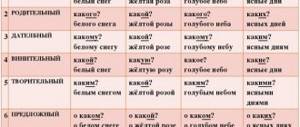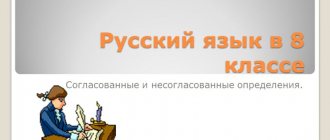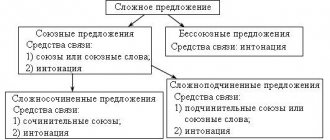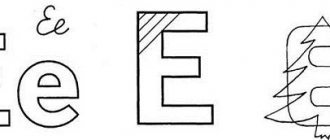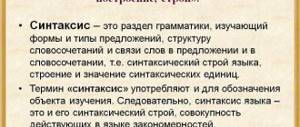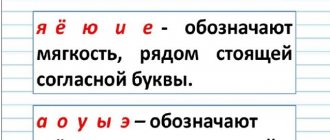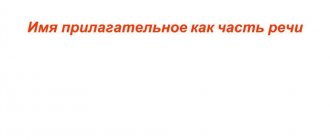Why do you need to know the alphabet?
Each of us knows what the alphabet and the alphabet are from childhood, or learn about it in the first grade of school. For those who forget, here is a definition of what an alphabet is: an alphabet is a collection of letters or other signs of a given writing system, given in alphabetical order. This definition is given to us by Vladimir Dahl’s explanatory dictionary. So, we have figured out the definition, but a new question arises, the answer to which I really want to know: why do you need to know the alphabet? We can say with almost one hundred percent certainty that this question plagues many primary school students who have to deal with learning the alphabet. Let's try to answer this heartbreaking question.
Why do you need to know the alphabet?
Let's start, perhaps, with the first thing that comes to mind, and, accordingly, with the most important thing. The alphabet is the basis for learning any language. Of course, you can learn to speak without knowing the alphabet, as evidenced by children who learn to speak without having the slightest idea of what kind of beast the alphabet is. But learning to speak is only one step in learning a language, because in addition to this, you also need to learn to read and write. But it is unlikely that you will be able to master these classes without knowing the alphabet. After all, in order to learn to understand letters and read them, first you just need to learn them. The situation is similar with writing - to write a letter, you need to know what it looks like and what sound it means. Thus, one can come to an extremely logical conclusion - without an alphabet it is impossible to master a language. And this applies not only to our native language, which we, in fact, learn from birth, but also to any other language that you decide to study.
In addition, the alphabet can be called an integral part of the development of civilization and culture, because it is thanks to the mastery of language that a person can begin to master other sciences, as well as transfer his knowledge to other people. So progress without language would be impossible, since knowledge would be lost over time, and since a language cannot be learned without an alphabet, another conclusion can be drawn - the alphabet is an important part of progress.
Where to start learning the alphabet?
Some parents believe that since there is a school, then this is where the child needs to study, this is where his head will be filled with knowledge and letters of the alphabet in order. But this is not an entirely correct opinion, because it will be much easier for a child to study at school if he still has time to acquire some knowledge, at least the most basic, at home. For example, he will start learning the alphabet.
If you are perplexed by the fact that you don’t know where exactly to start this learning process, then don’t be scared and just start with the game. Nowadays there are a wide variety of toys in stores that will help a child learn the alphabet. For example, cubes with the image of letters (for example, Zaitsev’s cubes), magnetic alphabets and other interesting toys that can attract the child’s attention and interest him first with their bright color, and then with their knowledge.
To begin with, it doesn’t matter at all in what order you learn the letters. If the child liked the letter “U” better, then why not learn it first instead of the letter “A”? For the first time, it will be enough that you simply begin to teach the letters with your child and he will gradually learn to distinguish them, and he will be able to learn the alphabetical order of letters at school, if by that time you have not yet had time to teach him this.
The alphabet is the most important part of any language. Without knowing the alphabet, people would not be able to read books, navigate catalogs, write down their knowledge... Well, without knowing the alphabet, you would not even be able to read this article. So you need to know the alphabet and teaching your child the alphabet is no less important than teaching him to count.
Children's research project “Why do people need letters?”
Lyudmila Makarova
Children's research project “Why do people need letters?”
Hello, my name is Dima Somov and I am 6 years old. Theme of my project (title)
:
“
Why does a person need letters ?” The goal of my
project is to find out how the alphabet appeared and why people cannot do without it?
When I was even younger, it was not clear to me (it is not clear how people read books, navigate using maps (understand maps, write SMS to each other. But later, having matured a little, I realized that they succeed in all this because they know the letters ... I also wanted to quickly become smart and grown up, and then I started studying the alphabet. But where did it come from, and who invented it?
While I was preparing my research , I found out from the Internet that the very first alphabet (Slavic)
for the Russian people, two educated
(literate)
brothers Cyril and Methodius came up with it.
They came up with names and pictures for the letters . But their alphabet had as many as 43 letters ! But that was a very, very long time ago and since then a lot has changed (changed)
.
letters in our alphabet . Well, what is the alphabet, I asked our speech therapist Lyudmila Aleksandrovna. She explained to me that the alphabet is the order of letters . After all, everything that surrounds us in life should have its own order, and so do the letters , each with its own place and meaning. By the way, all the letters of the alphabet are familiar to me now!
But I didn’t stop there. I began to notice where and how adults use letters . For example, when my grandmother and I went into a store, I paid attention to the products; each of them had something written on it. On the milk carton I read “Milk”
, on the box with oranges I read -
“Oranges”
. So I realized that the order on the shelves in the store is associated with the alphabet.
You know, there are such books, these are very smart books, they are called reference books, dictionaries, encyclopedias. Without an alphabet, everything would be jumbled and incomprehensible. But with the help of an alphabetical index, even books have order. For example, my last name is Somov and in the telephone directory we need to look for it among the last names that begin with the letter “S”
- try it very simply. And, if all the names were mixed up, then you would be looking for my phone number all day.
also letters on my parents’ smartphones, my mother told me that they are called a keyboard and need to ask questions to the Internet or write SMS (messages)
to your loved ones or friends.
It turns out that with the help of letters it is easier for us to communicate .
And one day, when my dad and I were bored, he invited me to play an interesting game with him called “Battleship.”
.
But to play it you need to know the letters (at least from A to K)
.
We had a lot of fun, it turns out that the letters help in the fun too. What about crosswords or puzzles? We often
solve them
ABVGDeyka letters these games simply would not exist.
Now I am convinced that without letters a person’s life would be boring and lonely. After all, now that I know the alphabet, I can read a book myself, the name of a street, sign a postcard, write a message to a friend. That's why I say that letters will be very useful to me in life!
You know, my mother and I worked hard and created our own alphabet. each letter in a special way.
I hope you enjoyed listening to me! Thank you for your attention!
How to learn consonants: a game technique
There are many more consonants than vowels. Studying them will require more patience, effort and time. But everything will work out if you strictly follow the recommendations and take your time.
Prepare a table. Each table consists of six rows. On the top line, write or type hard consonants in blue and soft consonants in green. On the remaining lines, write short open syllables.
| BY | |
| BO | BYO |
| BOO | BYU |
| WOULD | BI |
| BE | BE |
| VYa | |
| IN | WHAT |
| VU | VYU |
| YOU | IN AND |
| VE | BE |
| GY | |
| GO | GYO |
| GU | GY |
| Gee | GI |
| GE | GE |
| DY | |
| BEFORE | DE |
| DU | DU |
| YES | DI |
| DE | DE |
| ZY | |
| ZO | ZY |
| memory | ZY |
| PS | ZI |
| ZE | WE |
| LA | |
| LO | LE |
| LU | Best Junior |
| LY | LI |
| LE | LE |
- Together with your child, sing songs of vowel sounds: in a rough low voice A, O, U, Y, E and in a high thin voice I, E, Yu, I, E.
- Say the consonants in the top line of the chart clearly. Work with 6 tables in each lesson.
IMPORTANT! Make sure that the child and you yourself pronounce the consonants clearly, so that no extraneous vowels Y or I . If the child gets used to saying D y, S y instead of the pure sounds D , S , then he will read incorrectly. The most difficult things to pronounce are the pure sounds B, V, G, D; B, B, G, D. The rest are easier, especially the deaf. Z and ZH correctly for example, is very simple. Ask your child: “How does a big mosquito buzz? Z-Z-Z. No, not Z s, but Z-Z-Z! The mosquito does not know how to say Zy , it does Z-Z-Z . How does a small mosquito buzz? ZZ-ZZ-ZZ . Komarik does not know how to say Z and, he does Z-Z-Z-Z . This is what we call these letters: Z-Z-Z and ZZ-ZZ-Z .”
- Sing the syllables in the same way as you did with the vowels.
- b in the tables and tell them that it is called a “soft sign.” Remind him of its name from time to time.
The letter b does not indicate a sound, but only INDICATES the softness of the consonant.
- Write Y . Name what this sound sounds like. Give examples of words that begin with this sound: iodine, yogurt, yogi.
the very name of the letter “ And short” later when he learns the alphabet. From time to time, remind your child about this letter by PRONING IT WITH A SOUND.
- Return to these tables several times a day and sing the warehouses with your child. Do this regularly.
- When you see that the child is doing everything correctly, replace the 2 tables with two new ones.
| MY | |
| MO | MIO |
| MU | Manchester United |
| WE | MI |
| ME | ME |
| AE | |
| BUT | NOT |
| WELL | Nude |
| WE | NI |
| NE | NOT |
The technique is the same. Sing all 6 tables daily with your child. As a result, the child will repeat the old ones and learn 2 new letters.
- Again replace the 2 tables with two new ones, etc.
If you stick to the plan “new things 2 times a week, repeat the rest of the days,” your child will learn 32 letters of the Russian alphabet in a month. Ъ to your child later, when he begins to read and encounters this letter in words.
IMPORTANT! In the Russian language there are twin sounds and warehouses: ZH-ZH, ZH-ZHYO, SH-SH, SHO-SHYO, CH-CH, CHO-CHE, SHCH-SHCH, SHCHO-SHCHYO, TSY-QI . They are spelled differently, but sound the same! Be sure to draw your child's attention to this.
Similarities and differences
In order not to get confused, and to make it easier to make a choice, let’s look at not only the differences, but also the similarities.
Similarities.
- Contains the alphabet. Both manuals were developed based on the alphabet and contain variations of it.
- Thematic illustrations. Both learning elements contain pictures representing words that begin with the letter displayed.
This is where the similarities end. Now about the differences between the alphabet (No. 1) and the primer (No. 2).
- View . The alphabet can be in the form of a book, cubes, magnets and much more, but the primer can only be in the form of a book.
- Order of the alphabet. The alphabet is an ordered system of signs, that is, the letters in it are arranged like in the alphabet - in a row. In the primer, letters are arranged according to the principle of ease of memorization and frequency. For example, in manual No. 2 the letter A is followed by O, and not B as in the alphabet.
- Directionality . Manual No. 1 is intended for learning letters, while the primer is aimed at teaching reading.
- Additional exercises . Based on its focus, the primer contains additional exercises for practicing reading skills; No. 1 does not have these.
- Age . Manual No. 1 was developed for preschool children, and No. 2 for primary schoolchildren.
Numeric value
The signs of the oldest known alphabets, in particular Ugaritic, were not used to represent numbers. Later in the West Semitic alphabets of the 1st millennium BC. e. and in the Greek alphabet the first letter in order [for example, Greek. α
(alpha)] can be the sign for the first integer of the natural series after zero (that is, “α” meant the number 1), the second for the second (“β” meant the number 2), etc. This principle has been retained in many systems , based on the Greek model, in particular, in the Old Slavonic and Old Russian. When the shape of a letter changes, its ordinal place in the alphabet and its numerical value are most often preserved, therefore, for studying the history of alphabets, methods of designating numbers are of great importance.
